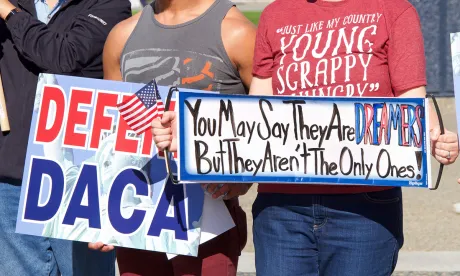On June 18, 2020, the U.S. Supreme Court ruled that the Trump administration’s attempt to end Deferred Action for Childhood Arrivals (DACA) fell short of the legal requirements for ending such a broad executive program. The Court held that the U.S. Department of Homeland Security’s (DHS) effort to terminate DACA was “arbitrary and capricious” and remanded the case for further consideration, leaving the program intact. The Trump administration had argued that DACA was an unconstitutional overreach of executive authority since it began in 2012.
The 5 to 4 opinion, written by Chief Justice John Roberts, only addressed DHS’ “procedural requirement that it provide a reasoned explanation for its action” and made no official determination regarding DACA’s legality or political merits. Chief Justice Roberts explained: “Here the agency failed to consider the conspicuous issues of whether to retain forbearance and what if anything to do about the hardship to DACA recipients. That dual failure raises doubts about whether the agency appreciated the scope of its discretion or exercised that discretion in a reasonable manner.”
The technical nature of the decision allows DACA to continue, but leaves the door open to a more detailed and measured attempt to end the program by the Trump administration.
What is DACA?
In 2012, the Obama administration utilized the executive branch’s broad discretionary immigration enforcement authority to create DACA: a temporary, renewable shield from deportation issued in two-year increments with accompanying work authorization. DACA does not provide an official “legal” status nor any long-term solution to recipients’ undocumented status. To qualify, DACA applicants must have entered the U.S. prior to both June 2007 and their 16th birthday and meet certain educational and non-criminality requirements. Such individuals are often referred to as Dreamers, a reference to the DREAM Act, failed legislation seeking a long-term solution to their immigration status.
DACA has gained broad bipartisan support and is now used by over 600,000 foreign nationals living in the United States, with over 97 percent of DACA recipients legally employed under the program.
What is the Ruling’s Effect on Applicants?
Although no official word has been released by DHS, the executive department charged with administering DACA, legal analysts believe the Supreme Court’s ruling reverts DACA to the same status it held prior to DHS’ 2018 attempt to terminate it. Extensions are surely still available for current DACA recipients and new petitions are likely to be accepted in the near future for those who qualify, but never applied for DACA.
Extension petitions may be filed up to 150 days in advance of an applicant’s DACA end date. Given the processing delays caused by COVID-19 and the potential for additional delays arising from an announced DHS furlough if Congress does not act quickly to address the agency’s funding shortfall, we recommend that applications be filed as early as possible.
What’s Trump’s Next DACA Move?
The Trump administration could re-issue a new order to end DACA today, if it desires. Of course, any new attempt will be constrained by the Court’s ruling and face significant legal and administrative hurdles. There are also larger issues facing the administration that may delay any relevant action for a period. These factors effectively push any practical end to DACA beyond the November elections and subsequent presidential inauguration in January 2021, meaning the results of the election in November may determine the future of DACA as it relates to the executive branch. DACA supporters are rallying political support behind Joe Biden, who has promised to support Dreamers’ efforts to gain a long-term, regularized status.
How Does the Ruling Affect Employers?
Given the program’s large size, DACA has become an important source of employment across a swath of U.S. industries. Of note, there are thousands of DACA recipients currently working in the healthcare industry, many of whom are working on the COVID-19 front lines. Cross-industry support for the program was evident in the support briefs filed in the Supreme Court case on behalf of over 100 employers, including large tech companies like Microsoft and Apple.
Employers with DACA employees should follow the British adage to “keep calm and carry on.” DACA employees and job applicants should be treated the same as all others. Recent court cases underscore that actions to treat DACA recipients different than other job applicants or employees could result in violations of anti-discrimination provisions of the Civil Rights Act or other U.S. law. Wells Fargo has agreed to pay a $20 million settlement in a California federal case alleging discriminatory mortgage, student loan, and other lending practices against DACA recipients and Proctor & Gamble recently lost a bid for summary judgment when a Florida federal judge ruled that barring DACA job applicants is a discriminatory violation of the Civil Rights Act.
A DACA job applicant will likely provide an Employment Authorization Document (EAD) upon hire, but it is important for employers to remember they all applicants are free to use any qualifying I-9 documents. Employers should never demand a particular document from job applicants and should always take precautions to timely re-verify expiring documents and follow relevant rules related to employment with pending document extensions.




 />i
/>i

